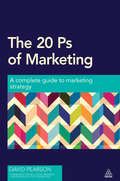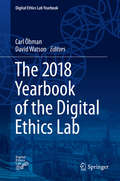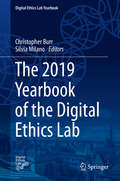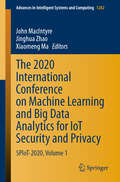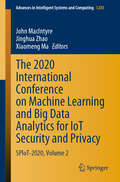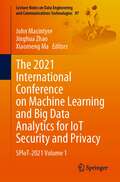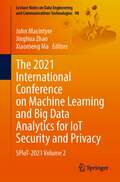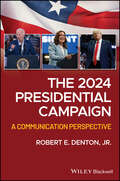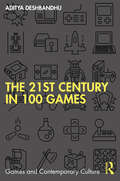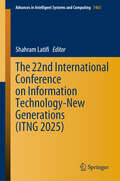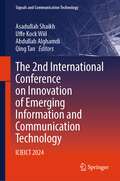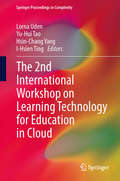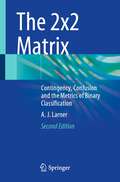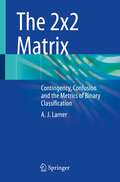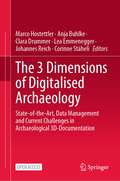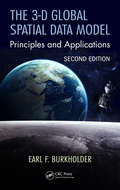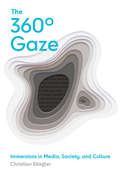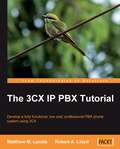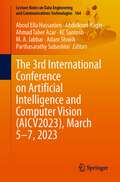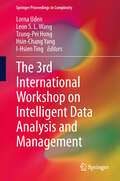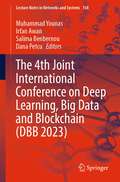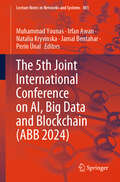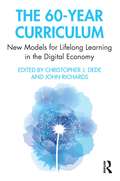- Table View
- List View
The 20 Ps of Marketing
by David PearsonMarketing has changed dramatically since the four classic Ps of the marketing mix (price, product, promotion and place) were proposed. The new marketing landscape is characterised by the demand for constant innovation, rising pressure on budgets, the growth of social media and the impact of issues of sustainability and ethical issues. As the business landscape has transformed so have the fundamental areas marketers need to master to succeed.The 20 Ps of Marketing provides a thorough guide to marketers at all levels of the new elements of the marketing mix they need to contend with for business success including: planning; persuasion; publicity; positioning; productivity; partnerships; passion and more. Combining practical advice with case studies it covers brands that have changed the game through mastery of the 20 Ps such as H agen Daz and Sony, and others, such as Kodak, who got left behind.This essential guide to the current face of marketing strategy provides marketers with a thorough and valuable grounding to the new fundamentals of marketing.
The 2013 Legal Technology Guide Solo and Small Firm
by Sharon D. Nelson John W. Simek Michael C. MaschkeThis annual guide is the only one of its kind written to help solo and small firm lawyers find the best technology for their dollar. You'll find the most current information and recommendations on computers, servers, networking equipment, legal software, printers, security products, smartphones, the iPad and anything else a law office might need. It's written in clear, easily understandable language to make implementation easier if you choose to do it yourself, or you can use it in conjunction with your IT consultant. Either way, you'll learn how to make technology work for you
The 2018 Yearbook of the Digital Ethics Lab (Digital Ethics Lab Yearbook #1)
by David Watson Carl ÖhmanThis book explores a wide range of topics in digital ethics. It features 11 chapters that analyze the opportunities and the ethical challenges posed by digital innovation, delineate new approaches to solve them, and offer concrete guidance to harness the potential for good of digital technologies. The contributors are all members of the Digital Ethics Lab (the DELab), a research environment that draws on a wide range of academic traditions.The chapters highlight the inherently multidisciplinary nature of the subject, which cannot be separated from the epistemological foundations of the technologies themselves or the political implications of the requisite reforms. Coverage illustrates the importance of expert knowledge in the project of designing new reforms and political systems for the digital age. The contributions also show how this task requires a deep self-understanding of who we are as individuals and as a species.The questions raised here have ancient -- perhaps even timeless -- roots. The phenomena they address may be new. But, the contributors examine the fundamental concepts that undergird them: good and evil, justice and truth. Indeed, every epoch has its great challenges. The role of philosophy must be to redefine the meaning of these concepts in light of the particular challenges it faces. This is true also for the digital age. This book takes an important step towards redefining and re-implementing fundamental ethical concepts to this new era.
The 2019 Yearbook of the Digital Ethics Lab (Digital Ethics Lab Yearbook)
by Christopher Burr Silvia MilanoThis edited volume presents an overview of cutting-edge research areas within digital ethics as defined by the Digital Ethics Lab of the University of Oxford. It identifies new challenges and opportunities of influence in setting the research agenda in the field.The yearbook presents research on the following topics: conceptual metaphor theory, cybersecurity governance, cyber conflicts, anthropomorphism in AI, digital technologies for mental healthcare, data ethics in the asylum process, AI’s legitimacy and democratic deficit, digital afterlife industry, automatic prayer bots, foresight analysis and the future of AI. This volume appeals to students, researchers and professionals.
The 2020 International Conference on Machine Learning and Big Data Analytics for IoT Security and Privacy: SPIoT-2020, Volume 1 (Advances in Intelligent Systems and Computing #1282)
by John MacIntyre Jinghua Zhao Xiaomeng MaThis book presents the proceedings of The 2020 International Conference on Machine Learning and Big Data Analytics for IoT Security and Privacy (SPIoT-2020), held in Shanghai, China, on November 6, 2020. Due to the COVID-19 outbreak problem, SPIoT-2020 conference was held online by Tencent Meeting. It provides comprehensive coverage of the latest advances and trends in information technology, science and engineering, addressing a number of broad themes, including novel machine learning and big data analytics methods for IoT security, data mining and statistical modelling for the secure IoT and machine learning-based security detecting protocols, which inspire the development of IoT security and privacy technologies. The contributions cover a wide range of topics: analytics and machine learning applications to IoT security; data-based metrics and risk assessment approaches for IoT; data confidentiality and privacy in IoT; and authentication and access control for data usage in IoT. Outlining promising future research directions, the book is a valuable resource for students, researchers and professionals and provides a useful reference guide for newcomers to the IoT security and privacy field.
The 2020 International Conference on Machine Learning and Big Data Analytics for IoT Security and Privacy: SPIoT-2020, Volume 2 (Advances in Intelligent Systems and Computing #1283)
by John MacIntyre Jinghua Zhao Xiaomeng MaThis book presents the proceedings of The 2020 International Conference on Machine Learning and Big Data Analytics for IoT Security and Privacy (SPIoT-2020), held in Shanghai, China, on November 6, 2020. Due to the COVID-19 outbreak problem, SPIoT-2020 conference was held online by Tencent Meeting. It provides comprehensive coverage of the latest advances and trends in information technology, science and engineering, addressing a number of broad themes, including novel machine learning and big data analytics methods for IoT security, data mining and statistical modelling for the secure IoT and machine learning-based security detecting protocols, which inspire the development of IoT security and privacy technologies. The contributions cover a wide range of topics: analytics and machine learning applications to IoT security; data-based metrics and risk assessment approaches for IoT; data confidentiality and privacy in IoT; and authentication and access control for data usage in IoT. Outlining promising future research directions, the book is a valuable resource for students, researchers and professionals and provides a useful reference guide for newcomers to the IoT security and privacy field.
The 2021 International Conference on Machine Learning and Big Data Analytics for IoT Security and Privacy: SPIoT-2021 Volume 1 (Lecture Notes on Data Engineering and Communications Technologies #97)
by John Macintyre Jinghua Zhao Xiaomeng MaThis book presents the proceedings of the 2020 2nd International Conference on Machine Learning and Big Data Analytics for IoT Security and Privacy (SPIoT-2021), online conference, on 30 October 2021. It provides comprehensive coverage of the latest advances and trends in information technology, science and engineering, addressing a number of broad themes, including novel machine learning and big data analytics methods for IoT security, data mining and statistical modelling for the secure IoT and machine learning-based security detecting protocols, which inspire the development of IoT security and privacy technologies. The contributions cover a wide range of topics: analytics and machine learning applications to IoT security; data-based metrics and risk assessment approaches for IoT; data confidentiality and privacy in IoT; and authentication and access control for data usage in IoT. Outlining promising future research directions, the book is a valuable resource for students, researchers and professionals and provides a useful reference guide for newcomers to the IoT security and privacy field.
The 2021 International Conference on Machine Learning and Big Data Analytics for IoT Security and Privacy: SPIoT-2021 Volume 2 (Lecture Notes on Data Engineering and Communications Technologies #98)
by John Macintyre Jinghua Zhao Xiaomeng MaThis book presents the proceedings of the 2020 2nd International Conference on Machine Learning and Big Data Analytics for IoT Security and Privacy (SPIoT-2021), online conference, on 30 October 2021. It provides comprehensive coverage of the latest advances and trends in information technology, science and engineering, addressing a number of broad themes, including novel machine learning and big data analytics methods for IoT security, data mining and statistical modelling for the secure IoT and machine learning-based security detecting protocols, which inspire the development of IoT security and privacy technologies. The contributions cover a wide range of topics: analytics and machine learning applications to IoT security; data-based metrics and risk assessment approaches for IoT; data confidentiality and privacy in IoT; and authentication and access control for data usage in IoT. Outlining promising future research directions, the book is a valuable resource for students, researchers and professionals and provides a useful reference guide for newcomers to the IoT security and privacy field.
The 2024 Presidential Campaign: A Communication Perspective
by Robert E. Denton Jr.A comprehensive communication analysis of the 2024 presidential campaign Presidential campaigns are more than elections, they are cultural touchstones that shape national identity and political discourse. The 2024 presidential campaign was a defining moment in American history, marked by political polarization and cultural turns. In The 2024 Presidential Campaign: A Communication Perspective Robert E. Denton, Jr. and a team of esteemed scholars offer an incisive look at the strategies, narratives, and media that influenced this landmark election. Examining all key areas of the 2024 election through the lens of communication, this timely volume delves into critical facets of campaign messaging, including political advertising and established news media. Discussions of recent developments such as AI-generated content and the expansion of alternative media provide a deeper understanding of how rapid technological advancement impacts both presidential campaigns and American democracy. Each chapter provides unique insights, connecting communication theory to real-world electoral phenomena. Presents in-depth analyses of televised debates, social media strategies, and advertising Explores the use of humor in computer-generated images and political cartoons Includes chapters on candidate branding and political party conventions Addresses the impact of campaign finance on electoral outcomes Offers the latest insights into digital and mediated campaign practices Provides a unique perspective on cultural and generational shifts in U.S. politics The 2024 Presidential Campaign: A Communication Perspective is essential reading for scholars and students in Political Science, Journalism, and Communication, particularly those studying presidential campaigns, media and politics, and the presidency. Ideal for upper-level undergraduate and graduate courses, it is also a valuable resource for professionals in political campaign management.
The 21st Century in 100 Games (Games and Contemporary Culture)
by Aditya DeshbandhuThe 21st Century in 100 Games is an interactive public history of the contemporary world. It creates a ludological retelling of the 21st century through 100 games that were announced, launched, and played from the turn of the century. The book analyzes them and then uses the games as a means of entry to examine both key events in the 21st century and the evolution of the gaming industry. Adopting a tri-pronged perspective — the reviewer, the academic, and an industry observer — it studies games as ludo-narratological artefacts and resituates games in a societal context by examining how they affect and are engaged with by players, reviewers, the gaming community, and the larger gaming industry.This book will be a must read for readers interested in video games, new media, digital culture (s), culture studies, and history.
The 22nd International Conference on Information Technology-New Generations (Advances in Intelligent Systems and Computing #1463)
by Shahram LatifiThis book covers technical contributions that have been submitted, reviewed and presented at the 22nd annual event of International conference on Information Technology: New Generations (ITNG) The applications of advanced information technology to such domains as astronomy, biology, education, geosciences, security and health care are among topics of relevance to ITNG. Visionary ideas, theoretical and experimental results, as well as prototypes, designs, and tools that help the information readily flow to the user are of special interest. Machine Learning, Robotics, High Performance Computing, and Innovative Methods of Computing are examples of related topics.
The 2nd International Conference on Innovation of Emerging Information and Communication Technology: ICIEICT 2024 (Signals and Communication Technology)
by Uffe Kock Wiil Asadullah Shaikh Abdullah Alghamdi Qing TanThis book presents the proceedings of the 2nd International Conference on Innovation of Emerging Communication and Information Technology (ICIEICT 2024), which took place October 20-23, 2024, in Casablanca, Morroco. The conference is devoted to communication, computer science, electrical and electronics engineering, telecommunication engineering, and information technology. The conference is intended to provide a forum for research scientists, engineers, educators, and practitioners throughout the world to learn, share knowledge, publish, and disseminate the most recent innovations and developments, ideas, and applications in all fields of science, technology and information technology.
The 2nd International Workshop on Learning Technology for Education in Cloud
by Lorna Uden I-Hsien Ting Hsin-Chang Yang Yu-Hui TaoProceedings from the 2013 LTEC conference in Kaohsiung, Taiwan. The papers examine diverse aspects of Learning Technology for Education in Cloud environments, including social, technical and infrastructure implications. Also addressed is the question of how cloud computing can be used to design applications to support real time on demand learning using technologies. The workshop proceedings provide opportunities for delegates to discuss the latest research in TEL (Technology Enhanced Learning) and its impacts for learners and institutions, using cloud technologies.
The 2x2 Matrix: Contingency, Confusion and the Metrics of Binary Classification
by A. J. LarnerThis book describes, extends, and illustrates the metrics of binary classification through worked examples.Worked examples based on pragmatic test accuracy study data are used in chapters to illustrate relevance to day-to-day clinical practice. Readers will gain an understanding of sensitivity and specificity and predictive values along with many other parameters.The contents are highly structured, and the use of worked examples facilitates understanding and interpretation.This book is a resource for clinicians in any discipline who are involved in the performance or assessment of test accuracy studies and professionals in the disciplines of machine learning or informatics wishing to gain insight into clinical applications of 2x2 tables.
The 2x2 Matrix: Contingency, Confusion and the Metrics of Binary Classification
by A.J. LarnerThis book presents and discusses the numerous measures of test performance that can be derived from 2x2 tables. Worked examples based on pragmatic test accuracy study data are used in chapters to illustrate relevance to day-to-day clinical practice. Readers will gain a good understanding of sensitivity and specificity and predictive values along with many other parameters.The contents are highly structured and the use of worked examples facilitates understanding and interpretation. This book is a resource for clinicians in any discipline who are involved in the performance or assessment of test accuracy studies, and professionals in the disciplines of machine learning or informatics wishing to gain insight into clinical applications of 2x2 tables.
The 3 Dimensions of Digitalised Archaeology: State-of-the-Art, Data Management and Current Challenges in Archaeological 3D-Documentation
by Johannes Reich Marco Hostettler Anja Buhlke Clara Drummer Lea Emmenegger Corinne StäheliThis open access book aims to provide an overview of state-of-the-art approaches to 3D documentation from a practical perspective and formulate the most important areas for future developments. Bringing together a wide range of case studies, examples of best practice approaches, workflows, and first attempts to establish sustainable solutions to pressing problems, this book offers readers current practical advice on how to approach 3D archaeology and cultural heritage.Divided into five parts, this book begins with an overview of 3D archaeology in its present state. It goes on to give insights into the development of the technology and recent cutting-edge applications. The next section identifies current challenges in 3D archaeology and then presents approaches and solutions for data management of a large number of 3D objects and ways to ensure sustainable solutions for the archiving of the produced data. This book will be of interest to researchers working in the fields of archaeology, heritage management, and digital humanities in general.
The 3-D Global Spatial Data Model: Principles and Applications, Second Edition
by Earl F. BurkholderTraditional methods for handling spatial data are encumbered by the assumption of separate origins for horizontal and vertical measurements, but modern measurement systems operate in a 3-D spatial environment. The 3-D Global Spatial Data Model: Principles and Applications, Second Edition maintains a new model for handling digital spatial data, the global spatial data model or GSDM. The GSDM preserves the integrity of three-dimensional spatial data while also providing additional benefits such as simpler equations, worldwide standardization, and the ability to track spatial data accuracy with greater specificity and convenience. This second edition expands to new topics that satisfy a growing need in the GIS, professional surveyor, machine control, and Big Data communities while continuing to embrace the earth center fixed coordinate system as the fundamental point of origin of one, two, and three-dimensional data sets. Ideal for both beginner and advanced levels, this book also provides guidance and insight on how to link to the data collected and stored in legacy systems.
The 360° Gaze: Immersions in Media, Society, and Culture
by Christian StieglerA comprehensive study of the pervasive role of immersion and immersive media in postmodern culture, from a humanities and social sciences perspective.Virtual reality, augmented reality, mixed reality, and other modes of digitally induced immersion herald a major cultural and economic shift in society. Most academic discussions of immersion and immersive media have focused on the technological aspects. In The 360° Gaze, Christian Stiegler takes a humanities and social science approach, emphasizing the human implications of immersive media in postmodern culture. Examining characteristics common to all immersive experiences, he uncovers dominant metaphors, such as the rabbit hole, and prevailing ideologies. He raises fundamental questions about opportunities and risks associated with immersion, as well as the potential effects on individuals, communities, and societies.
The 3CX IP PBX Tutorial
by Matthew M. Landis Robert LloydA hands-on and practical tutorial that shows administrators how to implement and use 3CX and its range of functionality. Using real world experiences from the authors, you will learn tricks and tips that will help you develop and optimize your 3CX system. This book is for beginners who know nothing about 3CX or VoIP. It will guide them to set up a complete system. Advanced users will also gain insight from information on real-world hardware and software tips and tricks.
The 3rd International Conference on Artificial Intelligence and Computer Vision (Lecture Notes on Data Engineering and Communications Technologies #164)
by Ahmad Taher Azar Aboul Ella Hassanien Abdelkrim Haqiq M. A. Jabbar Parthasarathy Subashini Kc Santosh Adam SłowikThis book presents the proceedings of the 3rd International Conference on Artificial Intelligence and Computer Vision (AICV’2023) which will be held in Marrakesh, Morocco, during March 05–07, 2023. This international conference, which highlighted essential research and developments in the fields of artificial intelligence and computer visions, was organized by the computer, Networks, Mobility and Modeling Laboratory (IR2M), Faculty of Sciences and Techniques, Hassan First University, Settat, Morocco, the Scientific Research Group in Egypt (SRGE), Cairo University, and the Automated Systems & Soft Computing Lab (ASSCL), Prince Sultan University, Riyadh, Saudi Arabia. The book is divided into sections, covering the following topics: swarm-based optimization mining and data analysis, deep learning and applications, machine learning and applications, image processing and computer vision, sentiment analysis, and recommendation systems, and software-defined network and telecommunication.
The 3rd International Workshop on Intelligent Data Analysis and Management
by Lorna Uden I-Hsien Ting Hsin-Chang Yang Leon S.L. Wang Tzung-Pei HongThese papers on Intelligent Data Analysis and Management (IDAM) examine issues related to the research and applications of Artificial Intelligence techniques in data analysis and management across a variety of disciplines. The papers derive from the 2013 IDAM conference in Kaohsiung ,Taiwan. It is an interdisciplinary research field involving academic researchers in information technologies, computer science, public policy, bioinformatics, medical informatics, and social and behavior studies, etc. The techniques studied include (but are not limited to): data visualization, data pre-processing, data engineering, database mining techniques, tools and applications, evolutionary algorithms, machine learning, neural nets, fuzzy logic, statistical pattern recognition, knowledge filtering, and post-processing, etc.
The 4th Joint International Conference on Deep Learning, Big Data and Blockchain (Lecture Notes in Networks and Systems #768)
by Muhammad Younas Irfan Awan Dana Petcu Salima BenbernouThis book constitutes refereed articles which present research work on new and emerging topics such as distributed ledger technology, blockchains and architectures, smart cities, machine learning and deep learning techniques and application areas such as flight pricing, energy demand and healthcare.The intended readership of the book include researchers, developers and practitioners in the areas of deep learning, big data and blockchains technologies and their applications.
The 5th Joint International Conference on AI, Big Data and Blockchain (Lecture Notes in Networks and Systems #881)
by Muhammad Younas Irfan Awan Natalia Kryvinska Perin Ünal Jamal BentaharThis book is the 5th Joint International Conference on AI, Big Data and Blockchain (ABB 2024), 19–21 Aug 2024, Vienna, Austria. This book constitutes refereed articles which present research work on timely research themes such as novel AI methods and models, deep learning techniques, data analytics and hidden patterns, security, privacy and trust, blockchain data management, and fraud detection and prevention, among others. The intended readership of the book includes researchers, developers, and practitioners in the areas of AI, big data, blockchain techniques, technologies, and their applications.
The 60-Year Curriculum: New Models for Lifelong Learning in the Digital Economy
by Christopher J. DedeThe 60-Year Curriculum explores models and strategies for lifelong learning in an era of profound economic disruption and reinvention. Over the next half-century, globalization, regional threats to sustainability, climate change, and technologies such as artificial intelligence and data mining will transform our education and workforce sectors. In turn, higher education must shift to offer every student life-wide opportunities for the continuous upskilling they will need to achieve decades of worthwhile employability. This cutting-edge book describes the evolution of new models—covering computer science, inclusive design, critical thinking, civics, and more—by which universities can increase learners’ trajectories across multiple careers from mid-adolescence to retirement. Stakeholders in workforce development, curriculum and instructional design, lifelong learning, and higher and continuing education will find a unique synthesis offering valuable insights and actionable next steps.
The 6th International Conference on Wireless, Intelligent and Distributed Environment for Communication: WIDECOM 2023 (Lecture Notes on Data Engineering and Communications Technologies #185)
by Isaac Woungang Sanjay Kumar DhurandherThis book presents the proceedings of the 6th International Conference on Wireless Intelligent and Distributed Environment for Communication (WIDECOM 2023), which took place at Brock University, St. Catharines, Ontario, Canada, October 11-13, 2023. The book addresses issues related to new dependability paradigms, design, and performance of dependable network computing and mobile systems, as well as issues related to the security of these systems. The goal of the conference is to provide a forum for researchers, students, scientists and engineers working in academia and industry to share their experiences, new ideas and research results in the above-mentioned areas.
